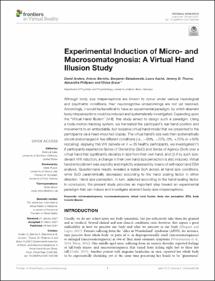Anders, David; Berisha, Arbnor; Selaskowski, Benjamin; Asché, Laura; Thorne, Jeremy D.; Philipsen, Alexandra; Braun, Niclas: Experimental Induction of Micro- and Macrosomatognosia : A Virtual Hand Illusion Study. In: Frontiers in Virtual Reality. 2021, Volume 2, Article 656788, 1-14.
Online-Ausgabe in bonndoc: https://hdl.handle.net/20.500.11811/9438
Online-Ausgabe in bonndoc: https://hdl.handle.net/20.500.11811/9438
@article{handle:20.500.11811/9438,
author = {{David Anders} and {Arbnor Berisha} and {Benjamin Selaskowski} and {Laura Asché} and {Jeremy D. Thorne} and {Alexandra Philipsen} and {Niclas Braun}},
title = {Experimental Induction of Micro- and Macrosomatognosia : A Virtual Hand Illusion Study},
publisher = {Frontiers Media},
year = 2021,
month = apr,
journal = {Frontiers in Virtual Reality},
volume = 2021,
number = Volume 2, Article 656788,
pages = 1--14,
note = {Although body size misperceptions are known to occur under various neurological and psychiatric conditions, their neurocognitive underpinnings are not yet resolved. Accordingly, it would be beneficial to have an experimental paradigm, by which aberrant body misperceptions could be induced and systematically investigated. Expanding upon the “Virtual Hand Illusion” (VHI), this study aimed to design such a paradigm. Using a body-motion tracking system, we translated the participant’s real hand position and movements to an embodiable, but resizable virtual hand model that we presented to the participants via a head-mounted display. The virtual hand’s size was then systematically shrunk and enlarged in five different conditions (i.e., −50%, −25%, 0%, +25% or +50% rescaling). Applying this VHI derivate on n = 35 healthy participants, we investigated (1) if participants experience Sense of Ownership (SoO) and Sense of Agency (SoA) over a virtual hand that significantly deviates in size from their own hand, and (2) if by such size- deviant VHI induction, a change in their own hand size perception is also induced. Virtual hand embodiment was explicitly and implicitly assessed by means of self-report and EDA analysis. Questionnaire results revealed a stable SoA across all hand size conditions, while SoO parametrically decreased according to the hand scaling factor in either direction. Hand size perception, in turn, adapted according to the hand-scaling factor. In conclusion, the present study provides an important step toward an experimental paradigm that can induce and investigate aberrant body-size misperceptions.},
url = {https://hdl.handle.net/20.500.11811/9438}
}
author = {{David Anders} and {Arbnor Berisha} and {Benjamin Selaskowski} and {Laura Asché} and {Jeremy D. Thorne} and {Alexandra Philipsen} and {Niclas Braun}},
title = {Experimental Induction of Micro- and Macrosomatognosia : A Virtual Hand Illusion Study},
publisher = {Frontiers Media},
year = 2021,
month = apr,
journal = {Frontiers in Virtual Reality},
volume = 2021,
number = Volume 2, Article 656788,
pages = 1--14,
note = {Although body size misperceptions are known to occur under various neurological and psychiatric conditions, their neurocognitive underpinnings are not yet resolved. Accordingly, it would be beneficial to have an experimental paradigm, by which aberrant body misperceptions could be induced and systematically investigated. Expanding upon the “Virtual Hand Illusion” (VHI), this study aimed to design such a paradigm. Using a body-motion tracking system, we translated the participant’s real hand position and movements to an embodiable, but resizable virtual hand model that we presented to the participants via a head-mounted display. The virtual hand’s size was then systematically shrunk and enlarged in five different conditions (i.e., −50%, −25%, 0%, +25% or +50% rescaling). Applying this VHI derivate on n = 35 healthy participants, we investigated (1) if participants experience Sense of Ownership (SoO) and Sense of Agency (SoA) over a virtual hand that significantly deviates in size from their own hand, and (2) if by such size- deviant VHI induction, a change in their own hand size perception is also induced. Virtual hand embodiment was explicitly and implicitly assessed by means of self-report and EDA analysis. Questionnaire results revealed a stable SoA across all hand size conditions, while SoO parametrically decreased according to the hand scaling factor in either direction. Hand size perception, in turn, adapted according to the hand-scaling factor. In conclusion, the present study provides an important step toward an experimental paradigm that can induce and investigate aberrant body-size misperceptions.},
url = {https://hdl.handle.net/20.500.11811/9438}
}






